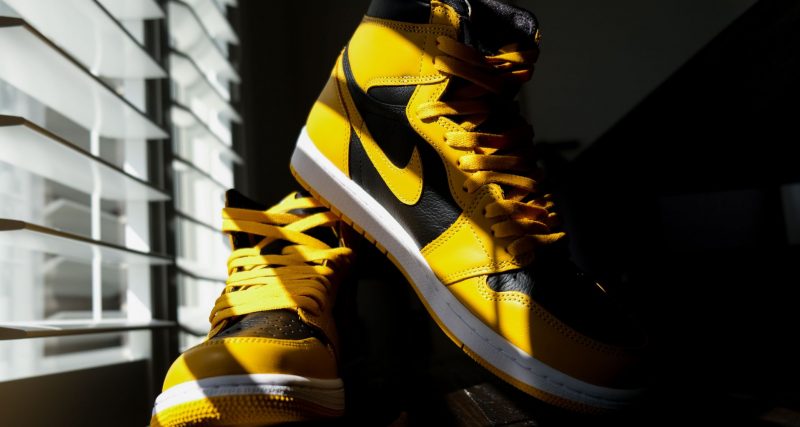Without a question, the Air Jordan 1 is one of the best shoes in history. The Jordan 1 has become a legend in its way over the last 35 years. During that period, the basketball shoe was seen on nearly everyone, from singers to metalheads, celebrities to skateboarders. More importantly, the Jordan 1 launched what we now know and adore as the Jordan Brand. However, it was not as straightforward a success story as you might believe.
The Jordan 1 has been a sneakerhead icon for nearly three decades. While the Air Jordan 1 is perhaps the most recognizable shoe of all time, it was not a favorite of Michael Jordan. As many sneakerheads are aware, the tale of the Jordan 1 is as essential to MJ’s career as his history with the Chicago Bulls. We’re going deep into the past of the AJ1 for the second installment of our Behind the Design series.
We’ll tell you about the Air Jordan 1, from the design process to its significance in popular culture. Without further ado, here is all there is to know about the Air Jordan 1.
ADVERTISEMENT
The Newcomer on the Block
Michael Jordan was widely expected to turn around the Chicago Bulls after joining the team in 1984. The entire country was following MJs when he established himself as a major player for the University of North Carolina’s Tar Heels. He had piqued the curiosity of nearly every major sports organization in the world. Though His Airness was a fan of Converse throughout his school days, he did not anticipate signing a signature contract with them because they already had Magic Johnson and Larry Bird as signature athletes.
Jordan was on the verge of signing with Adidas but was turned down again. adidas was not interested in expanding its product offering to basketball in the mid-1980s, which irritated Jordan. He would eventually sign with Nike, accepting a $500,000 contract that included his signature sneaker. Jordan was upset, but he realized how essential this marquee agreement would be for his career in the long term.
The Style
Michael Jordan had to wait nearly a year after signing with Nike for his debut sneaker. During his first season, he was frequently seen wearing the Nike Air Ship, which would later become the NBA-banned sneaker. That didn’t stop Nike from riffing on the forbidden idea when it introduced the Air Jordan 1. (more on that later).
With Michael Jordan being such an asset to Nike’s setup, Nike’s creator, Phil Knight, recognized that Jordan’s first trademark sneaker had to be significant. Jordan’s footwear was designed by Nike’s creative director, Peter C. Moore. Jordan supplied little specifications about how he wanted the shoe to appear, but he did give Moore two things to work with: the sneaker had to be lower cut than others and it had to be exciting.
The sporty footwear was embellished with silky leather and a huge Nike Swoosh. The Wings emblem, on the other hand, was the distinguishing feature. Moore created the Wings logo on the back of a napkin, combining Jordan and Nike. The words “Air Jordan” were written on a basketball with wings, alluding to Michael’s athletic skill and Nike’s Air Technology. Moore may have felt he had a slam dunk, but that was not the case.
ADVERTISEMENT
Moore’s response was, to say the least, unsatisfying for Jordan. Jordan was dissatisfied with the design, claiming that it would make him appear stupid in court. Things had not gotten off to a good start. However, Jordan gradually became fond of Air Jordan 1. Fortunately, he changed his mind. Jordan would eventually walk to the floor wearing the Air Jordan 1 and capture the attention of early sneakerheads.
It didn’t take long for the Air Jordan 1 to become well-known. The sneaker, which came in a variety of colorways, stood out above practically every other shoe on the floor. As predicted, several Chicago-themed variations were released, providing Jordan with a wide range of colorways to pick from. Jordan donned the “Bred,” “Chicago,” and “Black Toe,” but Nike also created a variety of non-Chicago variations.
The Prohibition and Success
Jordan was fined $5,000 every time he wore the sneakers on the court after receiving a letter from NBA commissioner Russ Granik claiming that the Air Ship did not comply with the 51% rule. According to the 51% rule, 51% of a player’s shoes must match his team’s uniform, which the “Banned” Nike Air Ship did not. Nike adopted this and ran with it, launching the most successful marketing campaign in the company’s history.
ADVERTISEMENT
Last Thoughts
That’s all there is to it! That is the creation and success story of one of Nike’s most iconic sneakers. The Nike Air Jordan 1 has been a staple in the sneaker culture for over four decades. Nike continues to develop collaborations and colorways of this iconic design, demonstrating its indisputable impact. Who knows what the world of footwear might have looked like if Jordan had left Nike?








